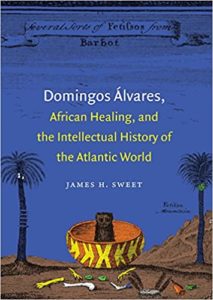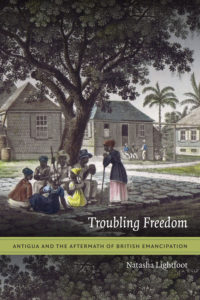In this article, I examine history books that were written to address Atlantic slavery in the 17th, 18th and 19th centuries. Each one provides a complex analysis and reveals that in order to truly understand the system of slavery, we must take into account all the layers of both systemic genocide, as well as the ways in which people of the African diaspora resisted for hundreds of years. Each one of these microhistories provides us a glimpse into the most barbarous system ever created and helps us understand the foundation of our global capitalist system.
According to Orlando Patterson in Slavery and Social Death, all slaves experienced a secular excommunication. Slaves were denied claim and responsibility to living blood relations as well as any ancestral lineage; denied a heritage. “…they reached back for the past, as they reached out to related living, there can be no doubt. Unlike other persons, doing so meant struggling with and penetrating the iron curtain of the master, his community, his laws, his policemen or patrollers, and his heritage.” Patterson is accurate in his assessment of colonial society fostering social death; institutions and individuals involved directly or indirectly with slave trade perpetuated this notion the slave had no life or narrative beyond their master. Executing a system and ideology of “socially dead” slaves ensured the master would have personal power. However, counter to Patterson’s perspective, resilience, resistance and the fight for civil rights pre- and post-emancipation, indicates people of the African diaspora had always retained their sense of humanity, elements of their culture and negotiated their freedom through daily acts of resistance.
 Domingos Álvares, African Healing, and the Intellectual History of the Atlantic World by James H. Sweet
Domingos Álvares, African Healing, and the Intellectual History of the Atlantic World by James H. Sweet
By observing the life of Domingos Àlvares, in the book, Domingos Àlvares, African Healing and the Intellectual History of the Atlantic World, by James H. Sweet, one observes the various stages of Atlantic slave trade and the attempted social death of its captives every step of the way, as well as resistance. In the kingdom of Dahomey (modern-day Benin and Togo), religious wars between Agaja’s monarchy and the Sakpata priests, gave way to political prisoners. Spiritual leaders like Àlvares were prime targets for enslavement and it is in West Africa, where the first stage of attempted social death took place. Once captured, prisoners were bound, stored tightly in the belly of the ship, temperatures reaching almost 120 degrees. The stench of illness, death, trauma and delirium permeated, as people struggled to survive the deadliest forced migration in history. It is difficult to identify the exact numbers of people that were subjected to Atlantic slave trade. Approximations say in the four centuries of European chattel slavery, ten to twelve million African people were trafficked to the Americas.
Once Àlvares was kidnapped to Brazil, he was sold to a rural sugar plantation owner and later to a slave owner in Rio de Janeiro. All the while he continued his spiritual healing work, never abandoning the practice he fostered in Dahomey. However, the Catholic church was another institution attempting social murder; it did the bidding of slave masters by perpetuating the notion African sources of healing were sinful, evil, dangerous and thereby illegal. This ensured the sanctity of the Catholic dogma as well as protecting slave masters from spiritual resistance. Despite the illegality, slaves in urban centers formed communities rooted in spiritual healing and realized it as a tool in addressing the misuse of power. With that said, Àlvares did integrate Catholic practices into his work; receiving baptism, answering to a Christian name and integrating prayer in his rituals. According to Sweet, Domingos could have seen the amalgamation of collective worship as a new healing community, providing a redemption song to the woes of enslavement. Indeed, the integration of African healing practices have survived in modern scientific methods such as Àlvares treating smallpox cases and healing a woman with Type 2 diabetes. This reveals the retention of African chemistry and medicine in the Americas.
Domingos Àlvares resisted social death from the moment he was captured and sold to slavery, to the time he was wandering Portugal after being exiled. While his healing practice and spirituality were his primary anchors, his community and kin were the only things allowing him to thrive and sustain. Ultimately the imperial stranglehold succeeded in physically and culturally isolating people such as Domingos and ensuring their demise. However, by observing Brazilian culture today as well as the broader Atlantic, one sees the retention of African traditions. African ancestral knowledge, transformed and influenced by European culture, interwoven with one another to be mutually exclusive while simultaneously mutually dependent.

Soul by Soul, Walter Johnson
In Walter Johnson’s Soul by Soul, life in the Louisiana slave market was not only a space where slaves were subjected to inhumane practices, but also reveals Black resilience and transcendence. The concept of chattel slavery and the abstract idea of attaching a price tag to human bodies was, in and of itself, an attempt at social death. Practices such as breeding and theories of race science ensured slaves had no claim of autonomy in the colonial world. Physicians like Samuel Cartwright believed the act of running away from the plantation was a indication of a mental disease, rather than an act of resistance to their current condition. He recommended slaves be made to work physically harder- breathe harder, ensuring they’d get enough oxygen to the brain.
In the antebellum South, being involved in slave trade was part of upward mobility and higher social standing for whites, compared to those that did not own slaves. The dependence of slave labor ensured slaveholders’ independence. “…Buying a slave was a way of coming into their own in a society in which they were otherwise excluded from full participation, in which even the independent exercise of the privileges of their whiteness was constrained by the property regime of slavery.” Slaves were keenly aware of their necessity and there is evidence they used tactics to manipulate buyers and shape their sale in the market to suit themselves. Being mindful of their responses to questions given by potential buyers, slaves framed the buyers’ perception. The more detailed the question, the better opportunity the slave had to negotiate the terms of the sale. Johnson also provides evidence slaves were very aware of Louisiana laws; court documents revealing slaves in court, reshaping the terms of their sale. Not only were they aware of the laws, they found a way to shape it to their advantage.
One of the most understated forms of resistance to social death found in slavery, was the ability for slaves to reclaim their humanity and time in the form of creative, leisure and joyful activity. “Slaves spun transcendence out of everyday activities: singing, praying, or playing; hunting, fishing and trapping; taking off at night or taking it easy during the day; or just talking, telling stories, and passing time that slaveholders thought belonged to them.” Enslaved people forged communities and selfhood in whatever time and space they could manifest for their own, and it allowed them to survive the most barbarous exodus in human history.


In Crossroads of Freedom and Troubling Freedom, Walter Fraga and Natasha Lightfoot respectively, illuminate the transition from enslavement to emancipation in Brazil and Antigua. In Antigua, Lightfoot explores the constraints of acquiring land ownership, survival tactics and labor organization in the pursuit of political rights. She also exemplifies the complications that came with conceptualizing freedom within an institutional government that was designed to restrict the autonomy of Black lives, and the efforts to ensure emancipation resembled slavery as much as legally possible. For example, The Contract Act was passed to push emancipated people back to exploited labor by contracting them to an employer (usually their former owner) for a fixed period of time. Blacks, usually illiterate, would enter these contracts verbally. If they were to read the fine print, they’d find clauses and provisions that limited their protections, subjected them to punishment and prevented them from seeking work elsewhere. Despite the legal contract binding them to abuse, freedpeople would often refuse to comply to the terms. Evidence of people flatly denying a contract even existed, broken contracts, or disputed terms in court, indicate freedpeople fought for labor rights.
In Crossroads of Freedom, Fraga illustrates the long transition to Brazilian freedom- beginning with the end of transatlantic slave trade in 1808 to May 13, 1888 with final abolition, and the decades following, where freedpeople attempted to distance themselves from their enslaved past. Migration patterns shifted following emancipation as well as the job market; freedpeople wanted to get off the plantations and often associated sugar planting work, with their past. This shift in labor, as well as a drought in 1889 cost many sugar planters their entire livelihood. Fraga mentioned accounts of former men of power, going insane and committing suicide. However, some slaves did remain in rural Brazilian sugar planting, partly because of economic immobility, or tending their subsistence farms. Those who remained on the plantation needed to define the terms of their labor. Fraga argued one the biggest challenges for freedpeople was the struggle dealing with power characteristics related to slavery. Ultimately, they affirmed their freedom by deconstructing the notion of seignorial authority. In a novel published twelve years after abolition by Xavier Marques, a former plantation slave said, “There are no more masters. These are different times. Today everybody is one. Everybody is as good as everybody else.” Fraga brings us back to reality, however, by reminding that racism was integral to daily life, despite an optimistic future.
According to Erna Brodber, Orlando Patterson is not implying slaves do not have a history because they were subjected to “social death,” rather quite the opposite. “Everything has a history, even sticks and stones,” interpreting and researching slave history requires us to de-slave the archives. Brodber calls for a “social resurrection” as we shift our conceptual framework of how we interpret the complexity of Atlantic slave history. Newer published works move to shift the narrative from not only how brutal slavery was, but to also highlight perseverance and efforts in seizing freedom, across the African diaspora. Monographs such as The House on Diamond Hill by Tiya Miles, also reveal to us the complexity of the slave narrative and the intersectionality of slaveholding-Cherokees and the power struggle with whites. Miles revealed the struggles slaves endured working on the Vann plantation, the presence of slaves on the Trail of Tears, as well as the erasure of the plantations slave-holding past from the historical landmark, today. The act of social reclamation within historical analysis of Atlantic slavery, is revolutionary. Social resurrection, reclaiming the impact slaves themselves had on their own emancipation, transforms history to heritage; history into a community of memory.
Sources:
Patterson, Orlando, Slavery and Social Death (Cambridge, MA: Harvard University Press, 1982), 5.
Sweet, James H., Domingos Àlvares, African Healing, and the Intellectual History of the Atlantic World (Chapel Hill: University of North Carolina Press, 2011) 17-22, 39.
Johnson, Walter, Soul by Soul: Life Inside the Antebellum Slave Market, (Cambridge, MA: Harvard University Press, 1999) 146.
Fraga, Walter, Crossroads of Freedom: Slaves and Freed People in Bahia, Brazil 1870-1910, (Durham: Duke University Press, 2016) 161-169.
Brodber, Erna, “History and Social Death,” Caribbean Quarterly, no 4, (December 2012): 111-115, accessed December 6, 2018. https://www.jstor.org/stable/43487737.
Miles, Tiya, The House on Diamond Hill: A Cherokee Plantation Story, (Chapel Hill: University of North Carolina Press, 2010)
